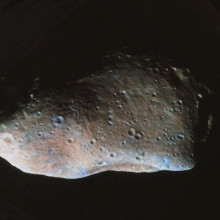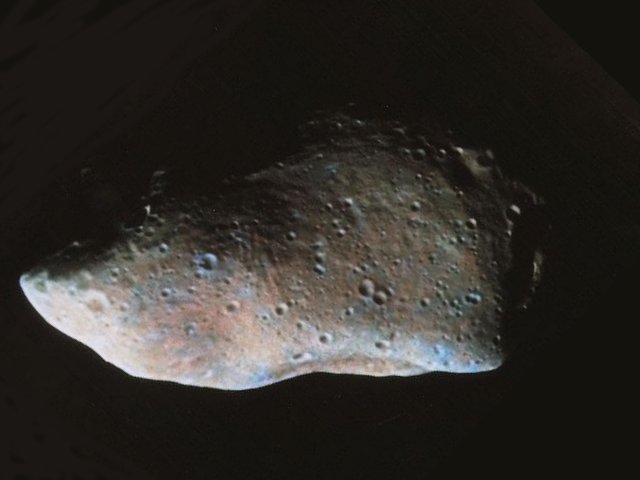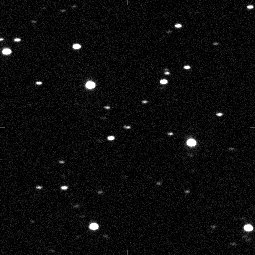Dark Planets and Dark Matter
25 September 2011
Presented by Ben Valsler, Carolin Crawford, Dominic Ford.
Are the foundations of Dark Matter crumbling? How can a planet be blacker than black paint? What are the sunsets like on a planet with 2 suns? In this month's Naked Astronomy, we'll discover Kepler-16b; a planet with two suns, we look to recent experimental results to see if the Cold Dark Matter theory still stands, and we explore the least reflective planet ever found...
In this episode

20:36 - Fact Impact - Asteroids
Fact Impact: A high-speed run-down of facts about Asteroids
Fact Impact - Asteroids
with Anna Dodge and Carolin Crawford
 There are several million asteroids contained within our Solar System.
There are several million asteroids contained within our Solar System.- Most travel in orbits at distances between 300 to 600 million km from the Sun
- ... in a region of space located between the orbits of Mars and Jupiter known as the asteroid belt
- ... which contains over forty thousand known objects of over 1km in diameter.
- Although it contains such a high number of objects, the asteroid belt is still only thinly populated, and several robotic spacecraft have travelled safely through it...
- ... the first one being Pioneer 10 in 1972.
- Overall, over 100,000 asteroids have been confirmed as detected, and at least 30,000 have well -determined orbits
- Based on both the spectra of their reflected light and the composition of samples that have fallen to Earth as meteorites, asteroids can be classified into 3 types - according to whether their composition is primarily carbon-rich, stony or metallic
- The majority - over 75% - are the dark carbon-rich objects
- The asteroids are thought to be the debris from shattered planetismals that were prevented from forming planets due to the strong gravitational tides created by nearby giant planet Jupiter
- The total mass of all the objects in the asteroid belt is still only about 4% of the mass of the Earth's Moon
 Asteroids have a wide range of size, from almost 1000km across down to 10s of metres in diameter
Asteroids have a wide range of size, from almost 1000km across down to 10s of metres in diameter- And the number of asteroids increases rapidly with decreasing size.
- Very few asteroids are round, and most are irregular in shape; this is partly due to collisions with other asteroids
- and because they are not massive enough to have enough gravity to pull themselves into a spherical shape
- Some asteroids even have their own satellite moons, such as little (1.5 km-across) Dactyl that orbits the 55km-long asteroid Ida.
- The first asteroid found was Ceres, which was discovered by accident by the Italian priest and astronomer Giuseppe Piazzi on the 1 January 1801.
- The name 'asteroid' was originally proposed by the British astronomer William Herschel, and was taken from from the Latin words aster, meaning star, and oid meaning rock or planet.
- Three more asteroids - Pallas, Juno and Vesta -- were discovered in the next 6 years...
- After that it was another 38 years until any more were found!
- Ceres is the largest object in the asteroid belt, and contains about 1/3 of the belt's mass...
- ... although with a diameter of 925km, more recently it has been reclassified as a dwarf planet.
 Even though it is nearer to Earth than Jupiter, it is too dim to be seen in the night sky with the unaided eye
Even though it is nearer to Earth than Jupiter, it is too dim to be seen in the night sky with the unaided eye- With a diameter of 535km, Vesta is the second most massive asteroid in the belt, containing about 10% of the mass in the belt.
- Analysis of the light reflected from the surface of Vesta reveals large basalt-rich regions suggesting that lava must have once flowed on the surface
- NASA's Dawn spacecraft was launched in September 2007 and it arrived at Vesta in July this year.
- This is the largest asteroid that has been visited to date...
- ... the first spaceprobe to visit an asteroid was NEAR Shoemaker, which landed on the surface of the asteroid Eros in 2001...
- And the Japanese spacecraft Hyabusa returned a sample from the surface of asteroid Itokawa in 2010
- After orbiting Vesta for 12 months Dawn will travel to examine Ceres in detail, arriving in 2015
- Vesta has a colossal crater 460km in diameter near its south pole, which lends the asteroid an overall look of a punctured football
- This crater is thought to be due to an enormous impact event less than a billion years ago
- Which spread debris from the asteroid far and wide.
- Indeed, about one in every 20 meteorites that falls to the surface of the Earth is probably a bit of Vesta










Comments
Add a comment